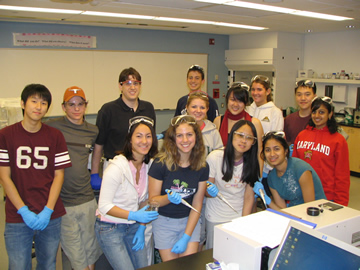 |
New Jersey Governor's School in the Sciences at Drew University |
 |
Drew Links |
|
| Team Projects | |
| NJGSS Home | |
| About NJGSS | |
Related Links |
|
| Drew University | |
2007 Team 1 |
||||||||
ENZYME KINETICS AND MECHANISM: INVESTIGATING SUBSTRATE PROTONATION BY ADENOSINE DEAMINASE Karen Cao, Edward Lee, Jennifer Liu, Dea Yong Park, Sharmila Railkar, Jyotsna Ramachandran, Jason Stickel, Laura Tiedemann, Lindsay Vendetta, Kurt Weiburth, Caitlin Williams Advisor: Dr. Adam G. Cassano |
||||||||
ABSTRACT In this study we observed how adenosine deaminase catalyzes reactions with adenosine and 6-chloroadenosine at different pHs that ranged from 7.3 to 9.4. The two substrates differed in that 6-chloroadenosine has a Cl atom in the same location where adenosine has a NH 2 group; this NH 2 group needs to be protonated in order for the reaction to occur, whereas the Cl does not. The goal of the experiment was to see whether the structure of 6-chloroadenosine changed the pH dependence relative to that of adenosine. The samples with different concentrations of adenosine or 6-chloroadenosine and different pH buffers were passed through a spectrophotometer at wavelength 260 nm and 264 nm respectively. Using the absorbance of each sample over time, the k 2 and K m could be calculated using the Michaelis-Menten equation. We found that at higher pHs, such as 8.9 to 9.4, the 6-chloroadenosine was not as pH dependent as adenosine; however, at lower pHs, such as 7, the two substrates were relatively similar in pH dependence. The k 2 decreased at lower pHs with the adenosine substrate than for 6-chloroadenosine. However, more samples need to be run in order to confirm that 6-chloroadenosine has an advantage at higher pHs. For future research, additional functional groups in adenosine deaminase mutants and a broader pH spectrum should be tested. |
||||||||
|
||||||||
